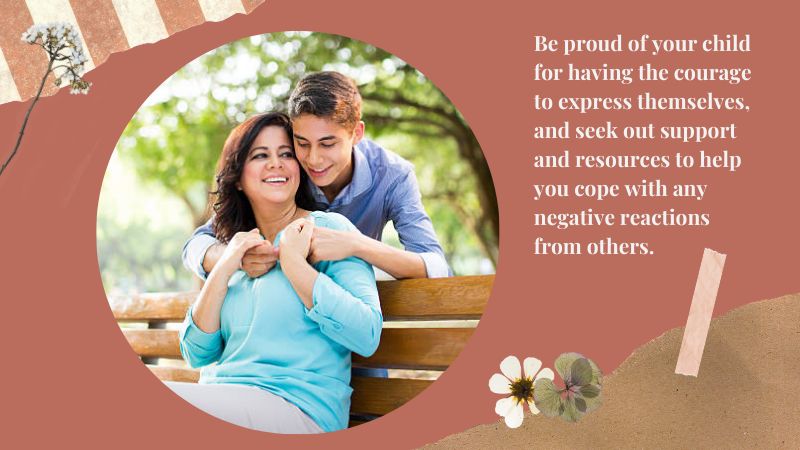My Son is Crossdressing: What Do I Do Now?
As a parent, it can be challenging to see your child engage in behaviors that don’t fit traditional gender roles or societal expectations. Crossdressing, in particular, can be a difficult concept for many parents to grasp, especially if they’re not familiar with it. The idea of their son wearing clothing typically associated with girls or women can be unsettling, confusing, and even frightening for some parents.

However, it’s important for parents to understand that crossdressing is not something to be feared or judged. In fact, it’s a normal and healthy way for many teenagers to express themselves and explore their identities. As a crossdresser, I’ve seen firsthand the transformative power this hobby can have on a person’s sense of self and confidence.
In this article, I’ll be sharing some insights and advice to help parents understand their teen crossdressers better. We’ll discuss what crossdressing is, why teenagers might engage in it, and how parents can offer support and guidance. Whether you’re a parent struggling to understand your child’s crossdressing or a crossdresser who wants to help your parents accept and support your hobby, this article is for you. So, let’s dive in and explore this topic with an open mind and heart.
Understanding Crossdressing:

To better understand why teenagers crossdress, it’s important to first have a clear definition of what crossdressing is. Crossdressing is wearing clothing or accessories typically associated with a different gender than the one assigned at birth. This can include wearing dresses, skirts, high heels, makeup, and other traditionally feminine clothing or accessories.

While some people may crossdress for sexual or fetish-related reasons, most crossdressers engage in this activity as a form of self-expression or exploration. For many teenagers, crossdressing can be a way to explore their gender identity or express their creativity. It can also be a way to challenge traditional gender roles and expectations and break free from limiting stereotypes.
It’s important to note that crossdressing does not necessarily indicate a person’s sexual orientation or gender identity. While some crossdressers may identify as transgender or non-binary, others may identify as cisgender and simply enjoy the act of crossdressing.

Despite its many benefits and positive aspects, crossdressing is often misunderstood and stigmatized. Crossdressers may face discrimination, harassment, and even violence simply for expressing themselves in this way. As parents, it’s important to educate ourselves and our children about the harmful effects of discrimination and work to create a safe and accepting environment for all individuals, regardless of their gender expression.
Talking to Your Teen About Crossdressing:

If you suspect that your teen may be a crossdresser, it’s important to approach the topic with an open and non-judgmental mindset. Remember that your teen may be feeling vulnerable and self-conscious about their crossdressing, so it’s essential to create a safe and supportive space for them to share their thoughts and feelings.
One way to start the conversation is to simply ask your teen how they’re feeling and what’s been on their mind lately. You might say something like, “I’ve noticed that you’ve been wearing some different clothes lately. Is there anything you want to talk about?” or “I want you to know that I love and support you no matter what, and I’m always here to listen if you need someone to talk to.”

It’s important to avoid making assumptions or jumping to conclusions about your teen’s motivations for crossdressing. Instead, ask open-ended questions and listen carefully to their responses. Try to show empathy and understanding, even if you don’t fully understand or agree with their choices.
You might also want to consider seeking the help of a therapist or counselor who is knowledgeable about gender identity and expression. They can provide additional support and guidance for both you and your teen as you navigate this journey together.

Above all, remember that your teen needs your love and acceptance, no matter what. Your unconditional support can make all the difference in helping them feel confident and secure in their identity.
Supporting Your Crossdressing Teen:

Once you’ve had a conversation with your teen about their crossdressing, it’s important to offer them your support and guidance. Here are some strategies for supporting your crossdressing teenager:
Show your love and acceptance: Let your teen know that you love and accept them for who they are, regardless of their gender expression. This can help them feel more confident and secure in their identity.
Offer practical support: If your teen needs help to find clothing or accessories that fit their style, offer to go shopping with them or help them find resources online. You can also offer to help with makeup or hairstyling, if that’s something your teen is interested in.

Educate yourself: Take the time to learn more about crossdressing and the experiences of other crossdressers. This can help you better understand and support your teen and challenge any stereotypes or misconceptions you may have.
Find community and support: Encourage your teen to connect with other crossdressers or allies in their community. This can provide them with a sense of belonging and support that can be invaluable.

Address potential challenges: Crossdressing can sometimes bring up challenges, such as bullying or discrimination. Talk to your teen about these potential challenges and brainstorm strategies for how to address them if they arise.
Remember that every teen is unique, and what works for one may not work for another. The most important thing is to remain open, supportive, and communicative with your teen as they explore their gender expression.
Addressing Concerns and Fears

As a parent of a teen crossdresser, you may have many concerns and fears about your child’s well-being and future. Here are some of the most common concerns and strategies for addressing them:

Self-esteem concerns: You might worry that your child’s crossdressing is a sign of low self-esteem or insecurity. However, for many crossdressers, dressing up in clothing associated with the opposite gender can be empowering and affirming. Encourage your child to find clothing that makes them feel confident and comfortable, and praise them for their bravery and self-expression.

Educational concerns: You might worry that your child’s crossdressing will affect their academic performance or future career prospects. However, research has shown that gender nonconformity is not a reliable predictor of academic success or career achievement. Encourage your child to pursue their interests and passions, regardless of traditional gender roles or expectations.

Parental concerns: You might worry that your child’s crossdressing reflects poorly on you as a parent. You may also worry that other parents will judge you for allowing your child to express themselves in this way. However, it’s important to remember that your child’s well-being and happiness should always be the top priority. Be proud of your child for having the courage to express themselves, and seek out support and resources to help you cope with any adverse reactions from others.
Remember that every teen is unique, and what works for one may not work for another. The most important thing is to remain open, supportive, and communicative with your teen as they explore their gender expression. Addressing your concerns and fears and seeking support and resources can help your child feel confident and secure in their identity and live a fulfilling life.
Conclusion:

In conclusion, understanding and supporting crossdressing teenagers is a vital part of creating a more inclusive and accepting world. By learning more about crossdressing, communicating openly with your child, and offering love and support, you can help your teen feel confident and secure in their identity.
It’s important to remember that crossdressing is not something to be feared or judged. It is a normal and healthy way for many teenagers to express themselves and explore their identities. With empathy, understanding, and acceptance, we can create a world where all individuals can be themselves. This way, everyone can live their lives to the fullest.
If you’re a parent of a crossdressing teen, I hope this article has provided some helpful insights and strategies for supporting your child. And if you’re a crossdresser yourself, I hope this article has helped you feel seen and validated in your experiences.
Remember that you are not alone, and there is always support and community available for those who seek it. Thank you for taking the time to read this article. May we all continue to work towards a more accepting and inclusive world.
Tagged With:Support Groups for Parents of Transgender
- What to Expect for Your First Time Going Out as a Sissy in Public?
- Breaking Gender Norms: Why Gender Expression Is a Playground, Not a Cage
- Why 2025 Is the Best Time to Start Crossdressing and Express Your True Self
- The Truth About Crossdressing: History, Meaning, and Misunderstandings
- Joining TVChix: The Online Space That Changed My CD Experience
- Praise vs. Degradation: What Fuels Your Feminine Journey?
Established in 2009, We are a recognized manufacturer and seller of professional crossdressing products.
It is our aim to become not just the most creative manufacturer but also a very considerate seller, as we provide the best quality products for crossdressers all around the world.






















 Breast Forms
Breast Forms  Body Suit
Body Suit  Realistic Mask
Realistic Mask  Femini Girdle
Femini Girdle Hip & Butt Enhancement (8)
Hip & Butt Enhancement (8) Penis Prosthesis
Penis Prosthesis Fake Muscle
Fake Muscle Bikini
Bikini  Wig
Wig  Corsets
Corsets Course
Course service@roanyer.com
service@roanyer.com +8618652200711
+8618652200711 Facebook
Facebook YouTube
YouTube Twitter
Twitter Instagram
Instagram




